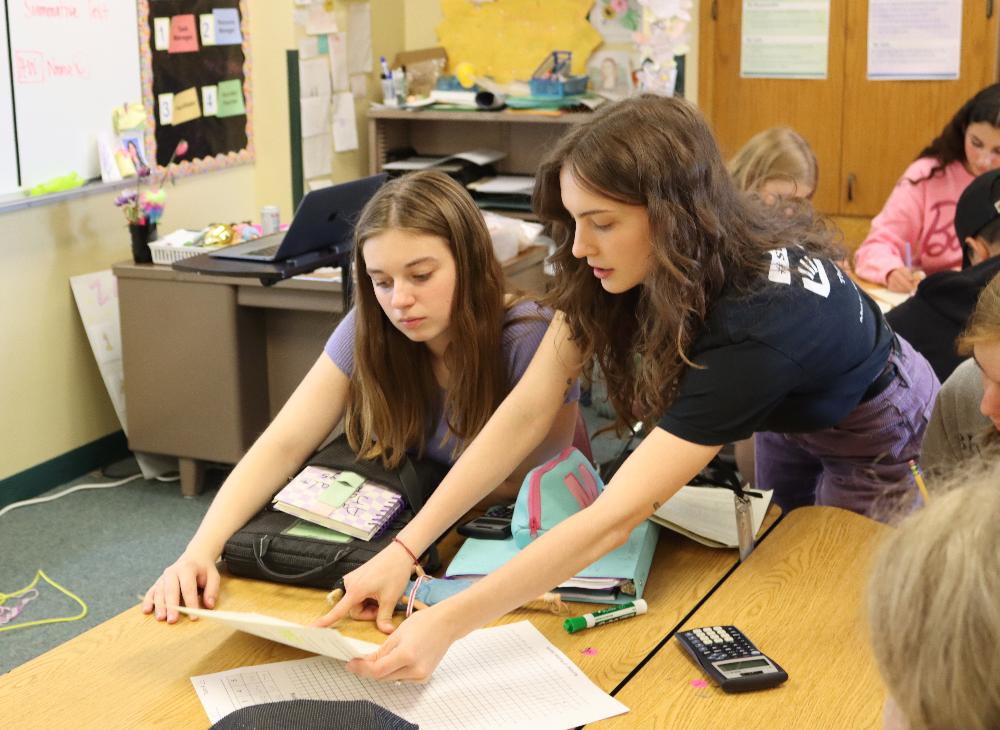Equations in Action: Barbie's bungee jump brings math to life at Lux
May 15, 2025
As soon as Delilah the Barbie doll bungee jumped toward the floor of Lux Middle School’s main hallway, students in Maggie Scott’s fifth-period math class let out a series of oohs and aahs.
“Wow! That was a good one!” they said as Delilah enjoyed a successful trip from the ceiling.
Lux eighth graders learned about linear equations between two variables with a fun Barbie-themed experiment in their Math Course 3 class. They measured how many rubber bands needed to be tied to Barbie’s feet to make the best possible bungee jump for her. They collected and analyzed data, constructed bungee cords and then watched their predictions take shape during a big drop.
Macy and Mariah both said they made good memories during the entire process. Teams of students gathered in Lux’s hallway to see if their equations would prove true in front of their classmates. In addition to having fun watching their Barbies, the lesson also illustrated many key math concepts such as organizing data in a scatterplot, calculating slope, using linear equations and identifying data associations.
“I really loved it,” Macy said. “I think Ms. Scott did a great job on making it fun.”
“It’s just really fun to do as a class and just seeing the different Barbies go down and seeing, ‘Oh, was 25 (rubber bands) enough? Or was 30 too much?’” Mariah said. “Kind of seeing the outcome.”

Scott and fellow Lux teacher Valerie Gerdes led eighth graders throughout the three-day experiment. The goal was for them to help Barbie fall as far as possible without touching the ground. Scott said hands-on activities like this were a great way for students to absorb math material.
“I haven’t been a teacher for very long, but I can say for certain, is just sort of regurgitating facts at a student or having them do rote memorization or rehearsing something over and over, that’s not going to help them learn it,” Scott said. “It may help them regurgitate a process, but not understand why and the why behind everything, so having a problem or a big experiment helps them to relate to all of the other things.
“They can hear, ‘X is your independent variable and y is your dependent variable.’ They can hear that. Or they see firsthand the number of rubber bands that I add to my bungee cord is going to make Barbie drop farther. So something like that, they have more of a tether, a grounding in the whole thing.”

Mariah agreed.
“It definitely helps a lot with learning and kind of just having that in the back of your mind,” Mariah said. “On a test or on a quiz, I’ll remember, ‘Oh, we did this equation for the Barbie drop.’ It kind of just helps you take in the learning material.”
Scott was a student teacher with Alicia Davis at Scott Middle School last year, and she watched Davis and Holly Noser conduct the Barbie bungee jump project with their students. Scott loved the activity and felt it would work well with her Lux classes this year.
Lux students began their experiment by forming small teams and tracking measurements of drop distances. They then created equations where ‘x’ equaled the number of rubber bands and ‘y’ represented the total drop distance. They transferred those equations to a chart that contained different graph points of ‘x’ and ‘y’ possibilities.

After collecting and analyzing their data, the teams predicted how many rubber bands they needed to attach to Barbie’s feet. Two of the six groups in Scott’s class felt 28 rubber bands would work best, and others calculated 20, 24, 25 and 35 for their bungee cord numbers.
Mariah’s group used the equation y=15x+32 to come up with a total of 25 rubber bands on their bungee cord. They then watched with anticipation as Scott placed their Barbie in a plastic holder, moved it to the ceiling and let the bungee drop begin.
“Ours went pretty close to the ground, but we definitely needed at least two more rubber bands,” Mariah said.
Macy said she liked working with her teammates on the project. Everyone stood in front of the class and presented their equation, which was y=9.4x+30. They also sat together as they compiled results from all of the other teams during the bungee jump time.
“I really liked being in a group,” Macy said. “It’s fun to, you know, have teamwork and have good conversations.”

Scott said she was impressed with the buy-in that all of her students displayed during the three days. They recorded detailed measurements in their notebooks, asked Scott many follow-up questions and showed a keen interest in giving Barbie good bungee jump memories.
“I was really proud of how on-task they were and how well they were working with each other, and not just like they need to get it done, but they were wanting to get it done,” Scott said.
Scott said the bungee jump experiment was part of a final series of lessons that would provide a solid foundation for high school math classes. She said it was fun to watch all of her students enjoy their time with the bungee jumping project.
“They were really, really excited,” Scott said. “I think that it’s just something good for the end of the year, just to get out of your seats and get ready for high school.”
Visit home.lps.org/math to view more resources about math classes available for Lincoln Public Schools students.
Do you have a story idea? Share it with the LPS Communications Team by filling out this form!
Published: May 15, 2025, Updated: May 15, 2025
Lux Middle School math teacher Maggie Scott works with eighth grader Macy on a linear equation for their Barbie bungee jump project. Students calculated how many rubber bands they needed to attach to Barbie dolls to give them the best possible bungee jumps.

